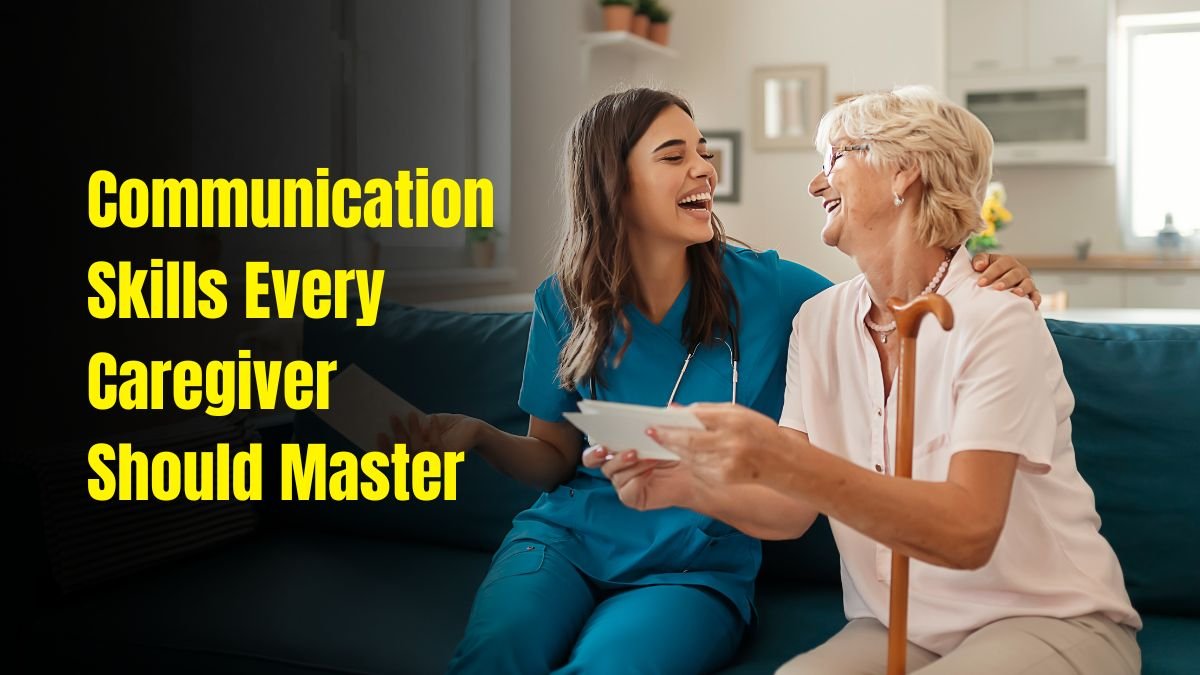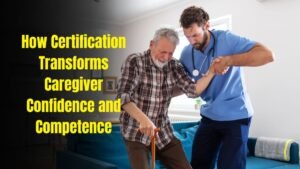In the world of caregiving, communication is as vital as clinical skill. Whether you are assisting older adults, patients with disabilities, or individuals recovering from illness, your ability to communicate effectively can determine the quality of care, emotional well-being, and safety of those you serve.
Good communication ensures that both the caregiver and care recipient understand needs, instructions, and feelings clearly.
In fact, studies show that effective communication among healthcare professionals and caregivers reduces stress, prevents errors, and promotes trust — the foundation of compassionate care.
This article explores the core communication skills every caregiver should master, detailing why they matter, how to develop them, and how they impact real-world caregiving outcomes.
Why Communication Skills Matter in Caregiving
Communication is more than just talking — it involves listening, empathy, body language, and patience. A caregiver who communicates clearly can:
- Reduce confusion during medication or treatment routines
- Strengthen emotional bonds with clients or families
- Prevent misunderstandings that could lead to safety issues
- Create a calmer, more cooperative care environment
Without good communication, even the most skilled caregivers can face burnout, frustration, and declining job satisfaction. Therefore, mastering communication skills is essential to ensure safe, efficient, and person-centered care.
Core Communication Skills Every Caregiver Should Master
Here’s a breakdown of the most important communication skills and how each contributes to effective caregiving:
| Skill | Why It Matters | How to Apply in Caregiving |
|---|---|---|
| Active Listening | Builds trust and ensures that the care recipient feels heard | Maintain eye contact, nod, and repeat what they say to confirm understanding |
| Empathy | Strengthens emotional connection and eases anxiety | Show understanding through kind words and tone |
| Clarity and Simplicity | Prevents confusion, especially with elderly or memory-impaired clients | Use short, simple sentences and repeat key information |
| Nonverbal Communication | Helps express care and reassurance | Use a calm tone, gentle gestures, and friendly facial expressions |
| Patience | Reduces tension and prevents frustration | Give time for responses, especially when communicating with dementia patients |
| Respectful Tone | Encourages cooperation and preserves dignity | Avoid talking down or using harsh language |
| Feedback and Confirmation | Ensures both sides understand instructions | Ask questions like “Does this make sense?” or “Would you like me to explain again?” |
| Adaptability | Adjusts to unique needs and emotions | Change tone, pace, or language based on the person’s mood or health condition |
1. Active Listening: The Foundation of Trust
Active listening involves giving full attention, acknowledging what the other person is saying, and responding thoughtfully. This helps build trust and improves understanding, especially when dealing with older adults or patients with cognitive limitations.
To practice:
- Maintain eye contact and avoid distractions
- Nod or verbally affirm (“I understand,” “Yes, that makes sense”)
- Summarize what the person has said to confirm accuracy
When care recipients feel heard, they’re more likely to share important information — such as pain levels, medication issues, or emotional distress.
2. Empathy and Emotional Awareness
Empathy allows caregivers to connect on a human level. It involves recognizing emotions and validating them — not just solving problems.
For example, instead of saying “Don’t worry, you’ll be fine,” try “I can see this is worrying you — let’s take it one step at a time.”
This approach fosters reassurance, reduces anxiety, and helps establish a caring bond that encourages cooperation and comfort.
3. Clarity and Simplicity in Speech
Caregivers often communicate complex information about medication, appointments, or care routines. Using simple, direct language helps avoid confusion.
Avoid jargon and long explanations. Instead of saying,
“Your medication needs to be administered in divided dosages twice daily before meals,”
say,
“You’ll take this pill in the morning before breakfast and again before dinner.”
Repeating important instructions and using visual aids (charts, reminders, color labels) can further enhance clarity.
4. Nonverbal Communication and Body Language
Nonverbal communication — gestures, facial expressions, posture, and tone — can often speak louder than words. A caregiver’s smile, calm presence, and steady tone can ease fear or agitation, especially for patients with dementia, hearing loss, or language barriers.
To strengthen nonverbal communication:
- Use gentle touch (if appropriate)
- Maintain open posture
- Avoid crossing arms or showing frustration
- Use a calm, warm tone of voice
Consistency between words and body language builds credibility and emotional safety.
5. Patience and Timing in Conversations
Patience is a vital skill when caring for seniors or individuals with neurological conditions. Many may need extra time to process or respond. Interrupting or rushing can cause confusion or distress.
Practical tips:
- Pause before repeating or rephrasing
- Maintain a calm demeanor even during misunderstandings
- Use humor and warmth to defuse tension
A patient caregiver fosters cooperation and makes the care experience more pleasant for everyone involved.
6. Conflict Resolution and Difficult Conversations
Disagreements are natural — between caregivers, patients, or family members. Having conflict resolution skills helps prevent stress and keeps focus on what matters: quality care.
Key techniques:
- Stay calm and neutral
- Listen to all sides before responding
- Focus on facts, not emotions
- Use “I” statements (e.g., “I feel concerned when…”)
- Aim for compromise, not control
Mastering this skill ensures smoother relationships, fewer misunderstandings, and a more supportive environment for care.
7. Feedback, Reassurance, and Confirmation
Effective caregivers check for understanding and reassure care recipients regularly. Confirming information prevents medication errors, missed appointments, or emotional distress.
Example: After explaining a new exercise routine, ask:
“Can you show me how you’ll do this?”
Repetition, written reminders, and follow-up questions are valuable for seniors who may have memory challenges.
8. Adaptability: Tailoring Communication to Each Individual
Every care recipient is unique — some prefer detailed explanations, while others respond best to brief cues. A caregiver must adapt communication to:
- Cognitive levels (e.g., dementia care requires gentle cues and short sentences)
- Cultural or language differences
- Emotional states (stress, sadness, confusion)
By staying flexible, caregivers can adjust their tone, pace, and message delivery to fit the individual’s comfort and understanding level.
How Communication Skills Improve Care Outcomes
| Communication Skill | Outcome for Care Recipient | Outcome for Caregiver |
|---|---|---|
| Active Listening | Builds trust and emotional safety | Reduces frustration and misunderstandings |
| Empathy | Increases satisfaction and cooperation | Strengthens relationships |
| Clarity & Simplicity | Prevents medication or care errors | Saves time and reduces confusion |
| Nonverbal Awareness | Enhances comfort and reassurance | Promotes calm, professional image |
| Patience | Reduces stress and conflict | Improves job satisfaction |
| Feedback | Ensures correct care delivery | Boosts confidence and accuracy |
| Adaptability | Personalized care experience | Strengthens versatility and skillset |
Overcoming Communication Barriers
Caregivers may face common barriers such as:
- Hearing or speech impairments in clients
- Language or cultural differences
- Emotional or cognitive decline
- Environmental noise and distractions
- Caregiver fatigue or stress
How to Overcome Them
- Use assistive tools (hearing aids, written notes, visual boards)
- Learn basic words in the recipient’s language
- Simplify instructions and speak slowly
- Find quiet spaces for important conversations
- Practice mindfulness and stress management techniques
How Training Enhances Caregiver Communication
Many caregiver training programs now integrate communication modules that teach empathy, conflict management, and person-centered interaction. Role-play, simulations, and practical feedback help caregivers refine these skills over time.
Ongoing communication workshops and certifications not only improve care quality but also boost career growth and confidence.
The Benefits of Strong Communication Skills
- Improved Safety – Reduces risks linked to poor instructions or misunderstandings.
- Higher Satisfaction – Clients feel respected and understood.
- Fewer Conflicts – Better relationships with families and healthcare teams.
- Increased Confidence – Caregivers feel prepared for emotional or complex conversations.
- Professional Growth – Enhanced soft skills lead to greater recognition and advancement opportunities.
Strong communication skills are the cornerstone of quality caregiving. They allow caregivers to connect emotionally, deliver accurate information, and navigate challenges with grace and understanding.
By mastering empathy, active listening, and adaptability, caregivers can create environments where both they and their clients thrive. Good communication doesn’t just make caregiving easier — it makes it more human, more effective, and more rewarding.
FAQs
What is the most important communication skill for caregivers?
Active listening is the foundation of caregiving communication. It ensures that clients feel heard, valued, and understood, which leads to stronger trust and better cooperation.
How can caregivers improve communication with dementia patients?
Use simple sentences, maintain eye contact, and employ nonverbal cues like gentle touch and smiling. Patience and repetition are essential.
Why do communication skills impact care outcomes?
Effective communication prevents errors, enhances trust, and improves both physical and emotional well-being for care recipients and caregivers alike.




